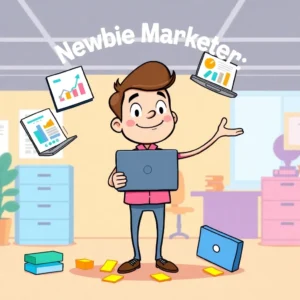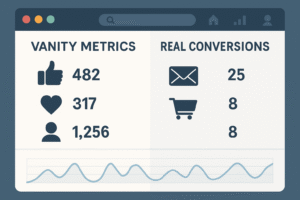7 Beginner Marketing Mistakes
These Are Killing Your Internet Profit Success

You’re pumped. You’ve got ideas. Maybe even a website. But something is off. Your traffic, your conversions, your enthusiasm… all seem stuck. If that rings a bell, you might be falling into one of the classic traps every newbie faces in online marketing. Fix these, and you’ll be paving the road toward Internet Profit Success.
In this guide I’ll share 7 beginner marketing mistakes (and how to dodge them), using related keywords like online marketer pitfalls and rookie marketing errors, plus some bonus hacks to help you start cleaner, smarter, stronger.
What Is “Internet Profit Success” Anyway?
Before we dive in, let’s clarify. By Internet Profit Success I mean making your online marketing efforts actually pay off, in leads, customers, engaged followers, or income, not just likes or empty traffic. It’s more than vanity metrics. It’s about doing the stuff that moves the needle long term.
Mistake #1: Not Defining Your Audience & Goals
One of the biggest rookie marketing errors is speaking to “everyone” and aiming for “more sales.” That’s vague; it’s like shouting in a stadium and hoping to hit someone specific.

If you don’t define who you’re talking to (audience avatars) and what outcome you want (specific goal), all your content, ads, emails, social posts will wander, misfire, or simply get ignored.
How to dodge:
Build 3-5 avatars: name them, note job/title, problems, fears, hopes, hobbies.
Choose ONE specific goal first: e.g. “gain 200 subscribers in 60 days” rather than “get more sales”.
Let these inform your messages: every headline, every content piece should feel like it is for one of your avatars, moving toward that goal.
Doing this cleans up your branding, your offers, your voice, and increases the chance your audience will actually engage or buy.
Mistake #2: Launching Without a Strategy Document
You wouldn’t build a house by just putting up walls and hoping for the roof. Yet many new digital marketers do the opposite: posting randomly, switching up messaging every week, no plan.
A strategy document (even a one-pager) forces you to think ahead. It captures:
Your main objective (what exactly do you want)
Who your audience is (from mistake #1)
Chosen channels (blog, email, social media, ads…)
Content schedule or timeline
Key performance metrics (what to measure)
Review weekly. Keep updating based on what’s working. This turns your marketing from chaos into machine. And machines can scale. That leads to real Internet Profit Success.
Mistake #3: Ignoring SEO & Keyword Research
This is huge. I’ve seen people banging out content with zero idea what people are actually typing into Google. That’s like opening a shop where no one knows the address.
If you don’t do keyword research, especially long-tail keywords, you’ll struggle to get organic traffic, and you’ll be fighting big brands for head terms you can’t compete with yet.
What to do:
Use tools like Google Keyword Planner, Ubersuggest, AnswerThePublic to find long-tail phrases relevant to your audience. E.g. instead of “digital marketing” go for “email marketing tutorial for beginners” or “social media content calendar tips for solopreneurs”.

Check search volume, competition, but also search intent, what does someone want when they type that phrase? Do they want information, ready to buy, comparison, etc.
Optimize your content: include the main keyword in the title, headings, meta description, and naturally within the body. But don’t overstuff.
Fill content gaps. See what competitors are doing; what they aren’t. If they only offer shallow tips, you go deep. If they lack visuals, you add infographics. If they skim the “why”, you dig into the “how” + examples.
Getting this right significantly helps your Google rankings, more organic traffic, better leads, all core to Internet Profit Success.
Mistake #4: Churning Out Low-Quality Content
Quantity is tempting: post often, crank out blogs, videos, reels. But if the content is thin, generic advice, vague, unhelpful, it won’t build authority, trust, or return visitors.
Low quality content is one of the biggest online marketer pitfalls. Worse: it can harm your brand. People remember fluff.
Here’s what to do instead:
Research deeply: see what top-ranking content in your niche is missing. Then fill those gaps.
Use visuals (screenshots, infographics), examples, case studies. Show, don’t just tell.

Give your audience actionable steps. Not just “do email marketing”, but “here are 5-step email sequence templates for re-engaging leads”.
Edit before you publish. Typos, weird formatting, broken links kill credibility.
When your content is solid, it becomes shareable, referenceable, usable. That alone helps in achieving Internet Profit Success because you’re building compounding value.
Mistake #5: Skimping on Mobile Optimization
If your site is perfect on desktop but terrible on mobile, you’re throwing away half your audience (or more). Mobile usage is massive. Google punishes slow or poorly displayed mobile sites. Users bounce fast if they can’t tap a button easily, or text is too small.

Some quick wins:
Use responsive design, test on multiple devices.
Compress images so pages load fast.
Ensure buttons, links, forms are easy to tap.
Use vertical or square formats for video/social media when needed.
Avoid slow, resource-heavy plugins or heavy scripting that blocks rendering on mobile.
Fixing mobile issues improves user experience, dwell time, and conversion, all vital to turning your marketing into profit.
Mistake #6: Going Full Blast on Social Without ROI Tracking
Posting everywhere can feel productive. It feels like you’re doing something. But without tracking what actually moves the needle, you may just be making noise.
Vanity metrics, likes, follows, eyeballs, are fun but don’t always lead to revenue or growth. Many newbies focus on reach rather than results.
How to avoid this rookie mistake:

Pick one or two platforms where your audience really hangs out. Do them well instead of spreading thin.
Use tracking: UTM codes, conversion events, measuring clicks, opt-ins, sales (not just views).
Set goals for each platform (e.g. “gain 100 email signups from Instagram stories this month”, or “drive 50 blog visits per week from LinkedIn posts”).
Analyze what content types perform: format, length, topic. Then do more of what works, less of what doesn’t.
When you know what converts, you can ramp up what works and drop what doesn’t, much more efficient path to Internet Profit Success.
Mistake #7: Scaling Too Fast Without Testing
Scaling feels exciting. Ads, content, tools, you throw in more. But without testing, you risk wasted budget, eroded brand trust, or worse.
This is one of those mistakes new digital marketers make that stings. If something breaks, you might not recover.
How to scale smart:
Always test first: launch small, with clear metrics (conversion rate, cost per acquisition, cost per email subscriber, etc.).
Use A/B tests, experiment. Try different ad images, subject lines, content formats.
Monitor results, tweak, optimize. If something works well, scale up. If not, pull back, adjust.
Don’t invest heavily until you’re confident, even in content, tools, outsourcing.
This approach protects your bottom line, helps you iterate toward what truly works, and keeps your momentum healthy.
Heads-Up: More Rookie Pitfalls (Bonus Round)
These are smaller, but often overlooked:
Forgetting about email list building. Social platforms change; email is one of the few you own.
Ignoring analytics. If you don’t know what your visitors do, you can’t optimize.
Neglecting internal linking. Helps SEO and keeps people exploring your content longer.
Not updating old content. Refresh, improve, old posts can bring new traffic with little effort.
Underestimating branding / trust factors. Video quality, design, messaging consistency matter.

Summary Quick Wins for Internet Profit Success
To wrap up: avoid the big blunders, lean into the good stuff.
Define your audience & goal from day one.
Create a simple strategy document and stick to it.
Do keyword research; use long-tails and match search intent.
Prioritize depth & value in your content.
Make sure your site works well on mobile.
Track real ROI, not just likes or views.
Test before scaling.
If you address those, you’ll dodge the worst beginner marketing mistakes, steer clear of online marketer pitfalls, and build real momentum. Internet Profit Success isn’t about shortcuts. It’s about doing the right things, consistently, with smart decisions.
Here’s a handy list of tools and resources — broken down by each trap:
1. Defining Your Audience & Goals
HubSpot Make My Persona – free tool to build customer avatars quickly.
Xtensio Persona Maker – great for creating sharable, pretty one-page avatars.
SMART Goal Worksheets (Google Docs) – templates for setting specific, measurable goals.
2. Strategy Document
Trello – organize campaigns, track tasks.
Notion or ClickUp – create living strategy docs, calendars, and content maps.
Google Docs – simple one-pager strategy doc, easy to share and update.
3. SEO & Keyword Research
Ubersuggest – beginner-friendly keyword and site analysis.
AnswerThePublic – shows common questions people ask (goldmine for content ideas).
Google Trends – spot trending topics and see if keywords are growing or fading.
Surfer SEO – helps structure posts based on top competitors.
4. Quality Content Creation
Grammarly or ProWritingAid – catch typos, polish writing.
Canva – create graphics, infographics, and social visuals easily.
Loom – make short explainer videos or walkthroughs.
Hemingway Editor – simplifies your writing for clarity.
5. Mobile Optimization
Google Mobile-Friendly Test – free tool to check if your site works well on phones.
GTmetrix or PageSpeed Insights – test site loading speed, get fix suggestions.
TinyPNG / Squoosh – compress images without losing quality.
6. ROI Tracking on Social
Google Analytics (GA4) – track website traffic, conversions.
UTM.io – create tracking links so you know which post drove the click.
Meta Business Suite / LinkedIn Analytics – monitor platform-specific performance.
Buffer or Hootsuite – schedule posts and check engagement.
7. Testing Before Scaling
Google Optimize (or alternatives like VWO) – run A/B tests on landing pages.
Facebook Ads Manager – test small ad campaigns before scaling.
Optimizely – advanced testing (a bit pricey but powerful).
Hotjar or Microsoft Clarity – see where users click, scroll, or drop off.
Bonus “All-Rounder” Resources
Neil Patel Blog & Podcast – super beginner-friendly, packed with step-by-step guides.
Backlinko (Brian Dean) – clear, tactical SEO tutorials.
Copyblogger – great for content writing and copy skills.
Coursera/HubSpot Academy – free beginner courses in digital marketing basics.
